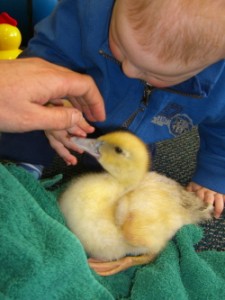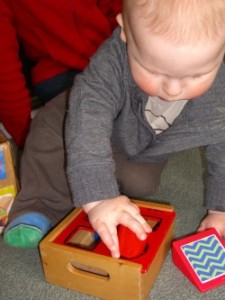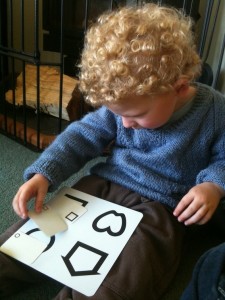Ryan is beginning to point to words on objects and is saying “What’s its name?”
Kathryn Beer (BLENNZ Resource Teacher Vision) describes the broad range of learning experiences that continue to support Ryan’s development of early literacy skills.
Real life experiences
Ryan’s early literacy development has included a range of hands-on experiences to build concepts. Whenever possible these have been repeated experiences to give Ryan a chance to practice a new skill as in figure 1.
Exposure to books
Exposure to books has been an important part of Ryan’s early literacy development.
Ryan’s first books were mostly of simple black and white pictures of shapes or objects.
Figure 2 shows Ryan at 11 months old turning the pages of a book with simple, clear photos.
Books have become a part of many daily routines. Plastic books in the bath, a book to hang onto in the buggy or car seat, as well as books shared at bedtime.
Hand-eye coordination
Hand-eye coordination is needed in print literacy, to be able to turn pages, hold a pen, and locate specific information on a page.
Ryan has explored a variety of activities to develop hand-eye coordination, including building towers with blocks and hammering tacks into small shapes onto a board.
In figure 3, Ryan (at 2 and a half years) is pointing to and talking about the cars lined up on a car transporter in a book about vehicles.
Shapes
Building the concept of shape has been woven through Ryan’s early literacy development.
We have worked on matching by colour, shape and/or size through activities such as comparing and sorting objects.
We have also included posting (Figure 4), and all kinds of puzzles.
Initially these activities used 3D objects, and progressed to first matching 3D shapes then to 2D symbols.
Ryan’s current skills
Ryan is able to tell the difference between specific shapes and symbols with which he is familiar.
He is able to match 2D symbols which represent the shapes used in the LEA Vision Test, as shown in figure 5.
He understands that specific shapes or symbols hold their shape even when they change in size.
Ryan is also able to match photos, as shown in figure 6, where Ryan is playing a lotto game, matching photos of food.
Ryan can match photos of his family, and the faces of people with whom he is familiar.
Ryan is showing interest in ‘writing’, ‘reading’ and ‘names’, for example, pointing to the words on a toy car door and asking “What’s that name?”, or pointing to any letter and saying “R for me”.
Next steps to support Ryan’s early literacy development
Next steps include giving Ryan opportunities:
- to develop the ability to visually discriminate finer detail in pictures and symbols,
- to be able to understand and relate these to real-life objects and experiences, and
- to use his growing ability to visually discriminate in developing patterns and sequences.
In the longer term, we will also be exploring Ryan’s awareness of the symbols of the alphabet, and his understanding that letters, words and text represent speech. As part of this programme of activities we will use ‘letter bags’, each bag filled with objects beginning with a particular letter.
These activities will maintain a continued exposure to books and bring Ryan’s attention to factors such as 1:1 relation between the printed word and spoken word.
We will also introduce iPad alphabet activities such as:
- matching letters,
- fun alphabet songs and games,
- phonics,
- matching letters with sounds.
Teaching and learning strategies and adaptations
I believe that building a trusting relationship with Ryan has been a vital part in allowing for successful interactions within the teaching framework. Teaching strategies included positive reinforcement and fun based activities, which have promoted a sense of confidence within the student.
As Ryan has low vision, adaptations were made to:
- increase contrast (for example, brightly coloured blocks on a dark mat as in figure 7),
- improve size,
- reduce visual and other sensory complexity (eg. books with a simple, well-contrasted background).
Strategies have also included opportunities for:
- hands-on, real experiences to assist in concept development,
- modeling,
- imitating,
- providing Ryan with clear expectations,
- exploring activities alongside each other.
The iPad has also been used to practice:
- matching,
- scanning a ‘page’,
- locating an object,
- visual-motor skills,
- 1:1 relation,
- the recognition and identification of form and symbols.
Assessment
Assessment has been both informal and formal, with reference to:
- developmental checklists,
- the symbols of the LEA Vision Test (hyper-link),
- pre-teaching tools associated with this test.
Ongoing evaluation of goals and strategies allows for the intervention to be tailored to Ryan individually, and on an ongoing basis.
Resources used to assess included:
- posting toys,
- form board puzzles,
- simple picture books,
- objects for comparing,
- sorting, matching,
- seriating,
- 1:1 relation,
- exploring colour, shape and size.
Useful links
- What is emergent literacy? on the Paths to Literacy website developed by TSVI and the Perkins School for the Blind.
- “Helping young students to develop emergent literacy skills” on the Paths to Literacy website.
More information
Email us at BLENNZ Online to find out more information about this subject.
We will link you up with either the author of this post or another BLENNZ colleague with whom you can continue your conversation.










